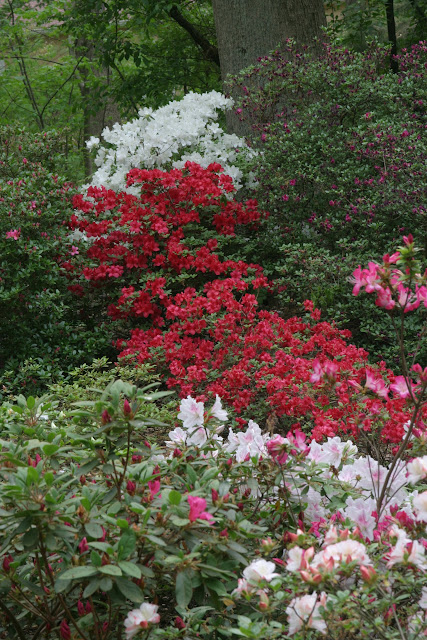Companion Plants
My mono-culture of azaleas looks great for a short time
in the spring, but then appears as the definition of ordinary.
Gardens need something else to carry them through, season by season.
The dense shade of an oak-covered yard dictates a summer palette of
subtle foliage, not blazing flowers.
There were a few remnant hosta in the yard when I came
up with the idea of watering the plants to keep them alive through
the summer. An original idea of my own and described in painful
detail elsewhere. So, the first thing I thought of when moving
beyond azaleas were hosta. Initially the ones I bought kept trying
to fool me. They changed color throughout the season. They grew
larger than they were when I bought them. They flowered. They died.
Just to be clear, not all the plants I bought died but there was a
range of behaviors that made planning difficult (especially the dying
part). Pictures in books, magazines and the net portrayed them at
just one point in time (usually with flowers). And no holes. Mine
had holes. Slugs? Insects? Falling sticks? Check, check and check.
Over time I found some that were fine: 'Sum and Substance', 'Fire
and Ice', 'Goodness Gracious' and 'City Lights' formed a backbone.
Visiting other gardens gave me more ideas.
Coming along with some gift azaleas, unbidden, were
Lady Ferns. Maybe ferns would like the beds. 'Leather Wood Fern'
and 'Autumn Fern' were large and held their presence. 'Christmas
Fern' was too coarse as I decided that ferns should be feathery, but
since I had a 'Christmas Fern' I kept it. The Lady Fern group, such
as 'Lady In Red' and the original 'Lady Fern', couldn't stand
Washington summers and so gave up, collapsing in a heap of
disorganized stalks every time the season got droughty. They
reappeared the next spring, though. 'Hay-scented Fern' looked
feathery but was a bully, invading everyone else's space and
requiring constant weeding.
Somewhat less well known, and shorter, were Heucheras.
They came in a variety of leaf shapes and colors (as long as you
liked green, tan and purple). A few were red(...ish), with some
imagination. Some had variegated leaves of silver and purple. The
flowers were really insignificant, but they were going into a foliage
bed with the hosta and ferns, so that didn't matter.
Critters rarely took bites out of the heucheras, which
made me curious. What did they taste like to be avoided by bugs and
rabbits? OK, are the children out of the room? Yes? Then I'll tell
you that I tasted them. Fibrous and bitter. Then I tasted the
plantain in the lawn that rabbits considered candy. Still fibrous,
though not as much, and with a strange aftertaste. Interesting. You
can let the children back in the room now. “Children, don't eat
the plants in the yard!”
 | |||
| Astilbe flowers L to R: 'Montgomery', 'Fanal', Chinensis | Background: Japanese Forest Grass, Heuchera 'Southern Comfort', Autumn Fern 'Brilliance' |
Gardeners suggested, and offered, a wide variety of
other shade plants. Some are still sitting in their pots and getting
antsy, frowning at me as I pass. Ones that have joined the
party are hellebores (great in early spring), variegated Solomon's
Seal (invasive), Bleeding Heart, Brunnera ('Jack Frost' would be a
first choice), Poppy, Geranium (good in flower but may be crushing
its neighbors), Astilbe (fine stalks of flowers for a short time),
Anemone, Begonia (invasive), Japanese Forest Grass (only weakly
invasive despite being a grass), Tiarella ('Foam Flower', nice in
bloom but nothing special otherwise), Wood Aster (wildly invasive),
Pulmonaria, Ligularia (like Pulmonaria, its spotted foliage is loved
by some, hated by those who think it looks diseased), Bloodwort (dies
back quickly after early spring) and Crosoganum (can't stand up well
to competition; I may not have any left that haven't turned to
compost).
Now I've got to find space for the different species
still on the outside looking in. Pots are like motel rooms, a
terrible way to spend a life. More holes to dig, dirt to mix.
The beds of herbaceous plants are now looking pretty
good. Maybe they need some companion plants. How about
azaleas?












